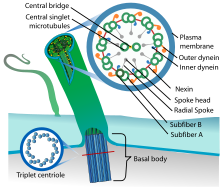Nephronophthisis
| Nephronophthisis | |
|---|---|
 | |
| Nephronophthisis has an autosomal recessive pattern of inheritance. | |
| Specialty | Medical genetics |
| Symptoms | Polyuria[1] |
| Types | Infantile, Juvenile and Adult NPH[2] |
| Diagnostic method | Renal ultrasound[2] |
| Treatment | Hypertension and anemia management[2] |
Nephronophthisis is a genetic disorder of the kidneys which affects children.[3] It is classified as a medullary cystic kidney disease. The disorder is inherited in an autosomal recessive fashion and, although rare, is the most common genetic cause of childhood kidney failure. It is a form of ciliopathy.[4] Its incidence has been estimated to be 0.9 cases per million people in the United States, and 1 in 50,000 births in Canada.[5]
Signs and symptoms
Infantile, juvenile, and adolescent forms of nephronophthisis have been identified. Although the range of characterizations is broad, people affected by nephronophthisis typically present with polyuria (production of a large volume of urine), polydipsia (excessive liquid intake), and after several months to years, end-stage kidney disease, a condition necessitating either dialysis or a kidney transplant in order to survive.[1] Some individuals that suffer from nephronophthisis also have so-called "extra-renal symptoms" which can include tapetoretinal degeneration, liver problems, ocularmotor apraxia, and cone-shaped epiphysis (Saldino-Mainzer syndrome).[6][7]
Cause
Nephronophthisis is characterized by fibrosis and the formation of cysts at the cortico-medullary junction, it is an autosomal recessive disorder which eventually leads to terminal kidney failure.[8]
Pathophysiology

Mechanism of nephronophthisis indicates that all proteins mutated in cystic kidney diseases express themselves in primary cilia. NPHP gene mutations cause defects in signaling resulting in flaws of planar cell polarity. The ciliary theory indicates that multiple organs are involved in NPHP (retinal degeneration, cerebellar hypoplasia, liver fibrosis, and intellectual disability).[9]
Related rare genetic disorders
Nephronophthisis is a ciliopathy. Other known ciliopathies include primary ciliary dyskinesia, Bardet–Biedl syndrome, polycystic kidney and liver disease, Alström syndrome, Meckel–Gruber syndrome and some forms of retinal degeneration.[10]
NPHP2 is infantile type of nephropthisis and sometimes associated with situs inversus this can be explained by its relation with inversin gene. NPHP1, NPHP3, NPHP4, NPHP5, and NPHP6 are sometimes seen with retinitis pigmentosa, this particular association has a name, Senior-Loken syndrome.[11]
Diagnosis

The diagnosis of nephronophthisis can be obtained via a kidney ultrasound, family history and clinical history of the affected individual according to Stockman, et al.[2]
Types
Management
The management of this condition can be done via-improvement of any electrolyte imbalance, as well as, high blood pressure and low red blood cell counts (anemia) treatment as the individual's condition warrants.[2]
Epidemiology
Nephronophthisis occurs equally in both sexes and has an estimate 9 in about 8 million rate in individuals. Nephronophthisis is the leading monogenic cause of end-stage kidney disease.[12]
References
- ^ a b Hildebrandt, Friedhelm; Zhou, Weibin (2007). "Nephronophthisis-Associated Ciliopathies". Journal of the American Society of Nephrology. 18 (6): 1855–71. doi:10.1681/ASN.2006121344. PMID 17513324.
- ^ a b c d e f g h Stokman, Marijn; Lilien, Marc; Knoers, Nine (1 January 1993). "Nephronophthisis". GeneReviews. Retrieved 1 August 2016.update 2016
- ^ "Nephronophthisis". Genetics Home Reference. Retrieved 2015-08-08.
- ^ Hurd TW, Hildebrandt F (2011). "Mechanisms of nephronophthisis and related ciliopathies". Nephron Exp. Nephrol. 118 (1): e9–e14. doi:10.1159/000320888. PMC 2992643. PMID 21071979.
- ^ page 831, Chapter 35, in: Avner, Ellis D.; Harmon, William; Niaudet, Patrick; Yoshikawa, Norishige (2009-08-20). Pediatric Nephrology (Avner, Pediatric Nephrology). Springer. ISBN 978-3-540-76327-7. (stating the incidence in the United States as 9 per 8.3 million people.
- ^ Kanwal, Kher (2007). Clinical Pediatric Nephrology, Second Edition (2nd ed.). McGraw-Hill. p. 205. ISBN 978-1-84184-447-3. Retrieved 9 August 2015.
- ^ Medullary Cystic Disease~clinical at eMedicine
- ^ Salomon, Rémi; Saunier, Sophie; Niaudet, Patrick (2009). "Nephronophthisis". Pediatric Nephrology. 24 (12): 2333–44. doi:10.1007/s00467-008-0840-z. PMC 2770134. PMID 18607645.
- ^ Hildebrandt, Friedhelm; Attanasio, Massimo; Otto, Edgar (2009). "Nephronophthisis: Disease Mechanisms of a Ciliopathy". Journal of the American Society of Nephrology. 20 (1): 23–35. doi:10.1681/ASN.2008050456. PMC 2807379. PMID 19118152.
- ^ McCormack, Francis X.; Panos, Ralph J.; Trapnell, Bruce C. (2010-03-10). Molecular Basis of Pulmonary Disease: Insights from Rare Lung Disorders. Springer Science & Business Media. ISBN 9781597453844.
- ^ Badano, Jose L.; Mitsuma, Norimasa; Beales, Phil L.; Katsanis, Nicholas (2006). "The Ciliopathies: An Emerging Class of Human Genetic Disorders". Annual Review of Genomics and Human Genetics. 7: 125–48. doi:10.1146/annurev.genom.7.080505.115610. PMID 16722803.
- ^ Hildebrandt, Friedhelm (2009). "Nephronophthisis". In Lifton, Richard P.; Somlo, Stefan; Giebisch, Gerhard H.; et al. (eds.). Genetic Diseases of the Kidney. Academic Press. pp. 425–46. ISBN 978-0-08-092427-4.
{{cite book}}: External link in|chapterurl=|chapterurl=ignored (|chapter-url=suggested) (help)
Further reading
- Simms, Roslyn J.; Hynes, Ann Marie; Eley, Lorraine; Sayer, John A. (2011). "Nephronophthisis: A Genetically Diverse Ciliopathy". International Journal of Nephrology. 2011: 1–10. doi:10.4061/2011/527137. PMC 3108105. PMID 21660307.
{{cite journal}}: CS1 maint: unflagged free DOI (link) - Hildebrandt, Friedhelm; Attanasio, Massimo; Otto, Edgar (2009-01-01). "Nephronophthisis: Disease Mechanisms of a Ciliopathy". Journal of the American Society of Nephrology. 20 (1): 23–35. doi:10.1681/ASN.2008050456. ISSN 1046-6673. PMC 2807379. PMID 19118152.
- Murray, Karen F.; Larson, Anne M. (2010-07-23). Fibrocystic Diseases of the Liver. Springer Science & Business Media. ISBN 9781603275248.
